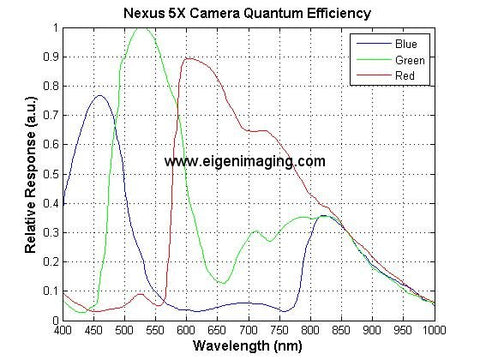Frequently Asked Questions
How broad is the range in which the NIR reflectance is measured? Is it from 800 to 1200 or more specific?
The enabled NIR sensitivity is up to about 1050nm

Is it possible to export the reflectance around 800 nm additional to the standard RGB values so that we have four bands with one value each?
No. The image captured is still stored as RGB color planes. Each color plane now has additional sensitivity in the NIR region.
Are all reflectance values measured at the same time with the same lens so that no co-registration is necessary?
Yes.
Can we export the images in a non-compressed form?
This will depends on the specific smartphone capabilities. All functions of the smartphone stay the same.
Which format will they have?
This will depends on the specific smartphone capabilities.
Can the images be exported only with your App or also independently?
All functions of the smartphone stay the same.
The camera will be mounted approximately 30 cm away from the plants. Is this within the working distance of the camera?
Yes.
Can you modify any camera modules?
No. Some camera modules are not made to be disassembled. Some do not have mechanism for readjusting the focus after modification, i.e. iPad Pro, Samsung S4, Tab A, etc. Please contact us for custom modifications.
What do you do to the camera module?
CMOS smartphone imaging sensors have sensitivity from visible to near infrared light. Imaging sensor manufacturers bond a near infrared blocking filter in front of the sensor to block out the near infrared part of the spectrum while still allowing the visible light to pass.
We remove the near infrared blocking filter and readjust the focus. All functions of the smartphone stay the same.
What is your dust speck blemish specifications
We have a specifically designed process for dust elimination as viewed at an integrating sphere output light port but in most cases there will be some dust specks blemish remain but often invisible in photographs.
Dust is a problem with all cameras and often finds its way to the the imaging sensor. It is not uncommon for a camera to attract and collect dust and debris on the image sensor. Digital camera users need to be aware of this potential blemish issue. While certain tests can be made to check if any blemish on the sensor don't represent real world shooting conditions and may lead to false positives.
Blemishes are visible spots or marks in the image, caused by sensor defects or by dust in front of the sensor (typically separated by the Bayer, anti-aliasing, and near infrared filters).
Our camera modules modified for NIR imaging is available in several different cosmetic grades, as shown below. Grade 1 is our standard modified camera module blemish specifications and thus suitable for Research and Development. Grade 1 is not suitable for critical application such as fundus imaging.
| Grade | Point Defects | Column Defects | Clusters Defects | Cluster Size |
| 1 | 50 | 3 | 5 | 10 |
| 2 | 100 | 6 | 10 | 25 |
Cosmetic Specifications Definition
| Point Defect | A black pixel or white pixel defect |
| Column Defect | A contiguous grouping of 10 or more white or black pixel defect pixels in a single column |
| Cluster Defect | A contiguous grouping of white or black pixel defects with a size less than or equal to Cluster Size |
| Black Pixel | A pixel with an amplitude less than 50% of the local mean when measured at half the pixel full well |
| White Pixel | A pixel with more than 10X the local dark signal |
What is the lead time?
Lead time is 1 to 2 weeks. Please contact us or up to date lead time when you ordered multiple units.
What form of payment do you accept?
We accept Credit Cards, PayPal, and Amazon checkouts. We do not accept Purchase Orders since our products are normally built-to-order per your requirements and thus advance payment is required before work can be started.
How do I order?
To order just go to the "Products" web page of our online store and select the product of interest:
Smartphone NIR, Camera Module NIR, Accessories.